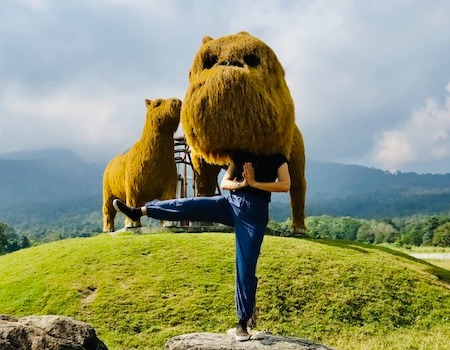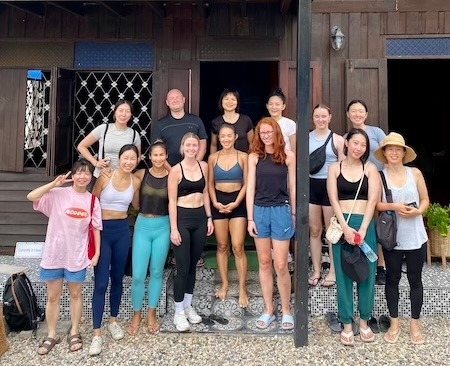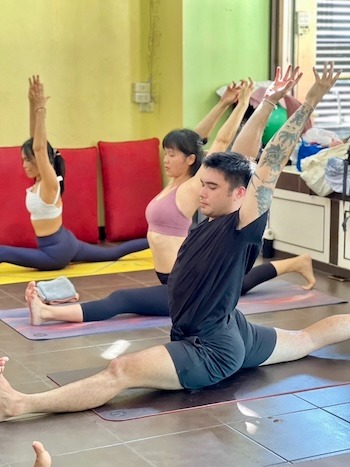Asana Journal
Before we start a yoga class, we usually do a chant or meditation to ground our mind and concentrate on the practice coming after. I see meditating before a yoga class as a ritual, through which I empty my mind for the duration of a class and set the intention of my practice.
When we talk about meditation, what usually comes to our mind is the seated pose with eyes closed in a quiet place. The meditation I am going to talk about is the one in our daily life. Nowadays, with social media, it is almost impossible to be away from digital devices. Our mind finds it so hard to concentrate that when we sit in a chair, the first thing we think of is: did anyone like my post 20 minutes ago? Ah no, 20 minutes is already too long—more like 5 minutes ago. It feels unbearable not to check the status of the post for that long. When we pick up our books and start reading where we left off, our logical mind is reading the words, but none of them make sense because we are wondering what our friends are up to on Instagram. After one paragraph, we put down the book and pick up the phone again…

This morning, after I finished cooking my lunch, I laid the dishes on the dinner table. I was about to turn on my TV, but then I decided not to. I told myself, let’s focus on the food this time. I felt the itch in my heart to have some distractions while I eat, but I convinced myself to give it a try anyway. For the first time in a while, I am giving myself the space and time to pay attention to the food in front of me. Instead of rushing to finish it and swallow it, I used my chopsticks to pick up one piece of meat at a time and chew slowly, with the voice in my head saying not to rush. It’s a weird feeling, to be honest. A lot of thoughts come up when I eat—sometimes it’s about the news I read earlier, other times it’s about what I am going to accomplish later at work.
I suddenly realised this is also a meditation—another kind of meditation. How we sit ourselves down and focus on whatever we are currently doing, and pay attention to the thoughts that pass by while we are physically doing something else.
I understand that people come to Chiang Mai to seek peacefulness and join a Vipassana workshop, because the environment does have some effect on our mental state. Being away from the noise or routines sometimes can make a difference. That said, we do not need to sit down in a temple and close our eyes to meditate. By concentrating on whatever we are doing, it’s already a way of meditating.
Just try to observe all the bits flying around your head and take them down piece by piece, and organise them. Once you do that, you come to a state of stillness and awareness.
The most popular and common yoga style in Chiang Mai is Vinyasa, especially in yoga studios that provide group classes. What makes Vinyasa so popular? I think it’s due to its flexibility. The teacher can adjust according to the students’ levels and offer different sequences during a one- or 1.5-hour class.
Since most Chiang Mai yoga studio students are walk-ins with different levels of experience, studios cannot provide classes dedicated to a single level. To accommodate everyone, they usually offer “all-level” classes, which begin with some warm-up and then flow through the hour. Teachers often add advanced or intermediate poses to spice up the sequence and make it more engaging.
In fact, flowing continuously for 1.5 hours is no easy task—it requires a strong body and well-trained muscles. So how do yoga studios or teachers manage to complete a 1.5-hour session without making it too difficult, while still keeping it enjoyable? Adding advanced or intermediate poses is one way to bring fun to the class. Students feel challenged if the poses are new to them, or accomplished if they turn out to be the only one who can do them.
We shouldn’t judge that—everyone has their ego. It’s not wrong to feed your ego with some fun once in a while.

While group classes are designed for walk-ins of different levels, private classes are tailored for those who want to improve specific aspects of their practice. We spend time doing self-practice and attending group classes, yet there comes a point when we feel stuck—like we’re not moving any further. During this bottleneck stage, we may feel discouraged, frustrated, or full of self-doubt. Talking to a third person who has experience usually helps, because they can see what’s missing in our practice and possibly how to improve—and what to improve on.
Taking private classes doesn’t necessarily mean you’ll break through right away. However, having another perspective is always useful when we feel lost.
Maybe you think private yoga teachers are just there to help improve the physical practice. In fact, since many yoga teachers in Chiang Mai like to do meditation in temples from time to time, they are often able to bring calm to our minds without us even noticing it.
Chiang Mai, one of the most visited cities in Thailand—and even in Asia—is famous for its laid-back atmosphere. People come here to unwind and take a break from their busy, day-to-day routines. The Thai saying “Jai Yen Yen,” which means “take it easy,” perfectly captures the spirit of the place.
So what helps you “take it easy” in Chiang Mai? It could be sipping coffee in a beautifully decorated café, riding an elephant through the lush jungle, taking a Thai cooking class, or perhaps, practicing yoga with people from all over the world.
Whether you’re an experienced yogi or a complete beginner, Chiang Mai’s yoga studios welcome everyone. People of all levels share their energy in the same space. With the soothing sound of “Ommmm” chanting in the background, you’ll find yourself slipping into a meditative state—letting go of thoughts and simply being in the present moment, guided by your teacher’s calm voice.

As a city that thrives on tourism, Chiang Mai naturally adapts to what visitors are seeking. Many locals see yoga as a meaningful path—not just for personal growth but also as a profession. While becoming a yoga teacher is no easy journey, many start their practice young and train rigorously to master their teaching skills. Opening a yoga studio has also become a way to achieve both creative and financial independence.
This growing demand for high-quality classes has created a healthy competition among studios, leading to the emergence of skilled, passionate teachers. As a result, yogis from around the world come to Chiang Mai not only for relaxation—but to learn from some of the best teachers in Thailand.
In a way, it’s a market-driven evolution, but one that beautifully blends business with mindfulness.
One question my friends often ask me is whether yoga can help with weight loss.
My answer is: it depends.It depends on the kind of yoga you practice and how often you practice it.
If your yoga sessions are mainly for relaxation, stretching, or unwinding, then probably not. But if you practice dynamic styles like Ashtanga or Power Yoga, which involve continuous movement and strength, then yes — yoga can help you lose weight.That said, I don’t believe yoga should be practiced for the purpose of losing weight.
As a friend of mine, an Ashtanga yogi, once said — “That’s very unyogi.”
Yoga is a union of body, mind, and spirit. If your only goal is to lose weight, you’re missing the deeper essence of the practice — the transformation of your mind and spirit.
Every time we step onto the mat, we set an intention: to start from where we are, and go as far as we can.
There will always be struggles —
Why can’t I get that asana?
I’m tired, maybe I should stop.
Chaturanga again? My muscles are screaming!These thoughts come up again and again throughout the practice, no matter how many years you’ve been doing yoga.
What matters is how you deal with them — how you talk to yourself, and how you keep going.Through yoga, we learn to accept our limitations, our imperfections, and yet, we continue to move forward. Every time you stand on the mat, you’ve already succeeded.
Did I lose weight after ten years of practice?
Actually, I did — just about 5 kilograms.
But what I’m proud of isn’t the number on the scale.
It’s my consistency — the fact that I’ve shown up for my practice, day after day.And I’m sure you’ll find your own kind of pride in yoga too.
Three stages to holding a bunny hop:
Learn to flip over on purpose — overcome the fear.
Practice falling safely when you tip over.
Find your midline and start holding the balance.
#chiangmai #yogateachers #yogainstructor #chiangmaiyogateachers
Place a 5–10 cm thick mat in front of you for protection. When you fall, bend your back leg so it lands on the mat first. And don’t forget to tuck your chin toward your chest as you roll over.
Shoulder strength is key to the pinch. Train it with Dolphin push-ups! #chiangmai #yogateacher #yogae
The press handstand is one of the most challenging poses I’ve ever tried. The hardest part is leaning forward without losing balance — it takes a lot of shoulder strength and strong finger grip. As Patrick said, you won’t get there right away; it’s about exploring the feeling and gradually getting used to it. #chiangmai #yoga #yogateachers
It was a big improvement once I overcame my fear of falling. I laid a cushion in front of me for protection, and with that in place, the fear gradually began to fade. In fact, I’ve learned how to fall gracefully now.
We accept major credit cards, Apple Pay, Alipay, WeChat Pay (for Mainland Chinese), Korean cards, KaKao Pay, Naver Pay, Samsung Pay, Bancontact, EPS, as well as iDEAL.
All bookings are non-refundable. However, you may reschedule or transfer your class to another person under the conditions below.
Rescheduling is allowed up to 24 hours before the class.
You may transfer your booking to another person with prior notice.
No rescheduling or transfers are allowed for late cancellations, no-shows, or arrivals more than 30 minutes late.
Yes, you can bring one friend or family member to join your session by adding 800 Baht per session.
If you’d like to add more friends or family members, please contact us.- Private yoga classes can be booked 7 to 30 days in advance. This allows both the teacher and the studio to be scheduled ahead, ensuring availability and a smooth experience.
- Yes! All teachers featured here are certified and bring years of experience. Each one has been carefully chosen for their quality of teaching and ability to create meaningful, personalized sessions. Additionally, teachers have different strengths and areas of expertise, so you can find one that best matches your practice goals.
- All classes take place at our Old Town studio in Chiang Mai. It’s centrally located for easy access, so you don’t have to worry about finding a spot. The space is designed to create a comfortable and focused environment for your practice.
- Not at all! Each teacher offers classes at different levels, and they can adapt the session to your experience and goals. Whether you’re a beginner or an advanced practitioner, you’ll get guidance tailored to you.
